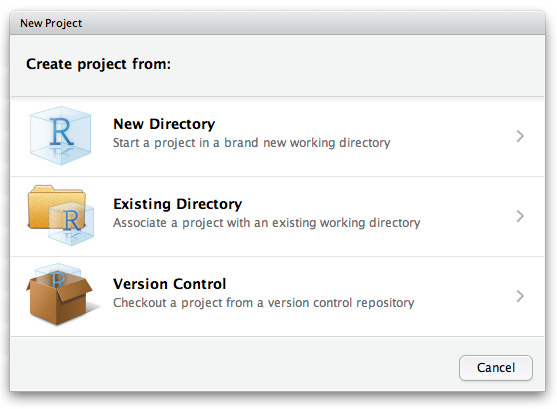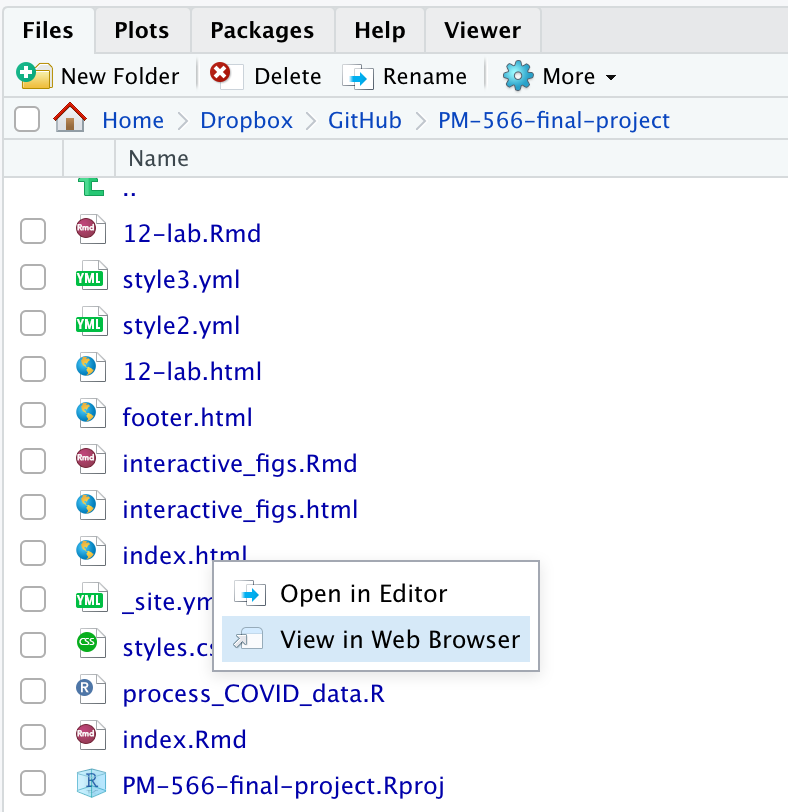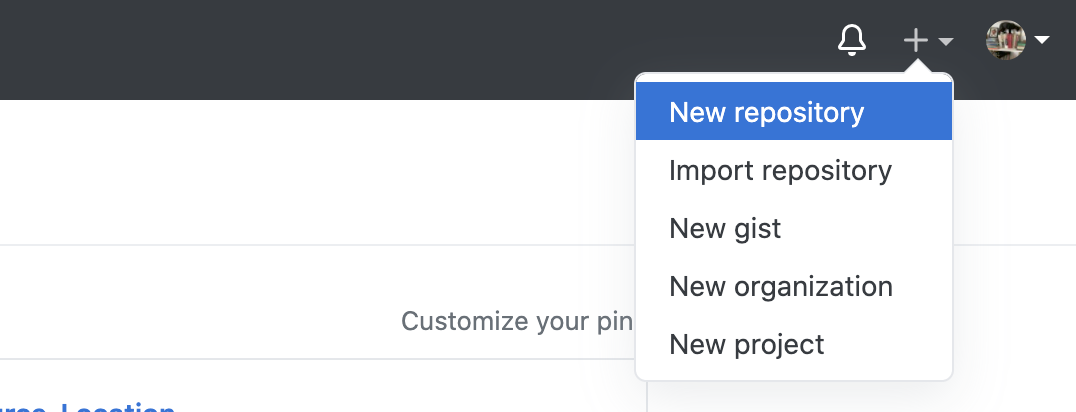Lab 12 - Create a project website
Abigail Horn
Edits by K Siegmund
Objectives
The objective of today’s lab is to create a project website using the rmarkdown package and deploy it using GitHub pages. We will include interactive visualizations on the website.
For this lab, we have created some initial content for you to work with as an example. The code is found at: https://github.com/ksiegmund/PM566-lab12-example.
Your objective will be to create your own project website using this content as a reference.
Note that if you want to create a personal website using the
rmarkdown package hosted on GitHub Pages, you can do so
following the same instructions, with the one difference that the
repository you create should be called
YOUR_GH_NAME.github.io.
Workflow Overview
Building websites uses the same reproducible workflow you can use for your analyses and collaborations. It is very iterative. You can do it all from RStudio, with a combination of clicking or typing commands as you feel comfortable.
There are two main steps for creating a personal website that will be hosted on GitHub:
I. Local setup
II. GitHub setup
I. Local Setup
The basic workflow is as follows:
- Create a project directory and an R Project file
(
.Rproj) - Create a
_site.ymlandindex.Rmdfile in your new directory - Add additional page content if desired through other
.Rmdfiles - Edit these files to create content and manage layout (and knit to view)
- Add a style sheet (CSS) if desired
- Build website
- Build tab > Build Website or
- in the console:
rmarkdown::render_site()This creates the output:index.html
Step 0: Look at existing content
Clone the website repository at https://github.com/ksiegmund/PM566-lab12-example with
example project website content into a NEW directory for the lab,
e.g. "week12-lab".
Note: we are not initializing this as a git repository, we will do that in Step 1. We are just downloading the contents.
mkdir ~/week12-lab
git clone https://github.com/ksiegmund/PM566-lab12-exampleThen open the file PM566-lab12-example.Rproj. For MacOS
you can do that through command line using
open PM566-lab12-example.RprojOtherwise, you can manually open the file from your directory.
Once you have it opened:
Check out the contents of this repository. What files does it contain?
Take a few moments to compare the contents of this repository to the final website at https://ksiegmund.github.io/PM566-lab12-example
Step 1: Create project website directory
Create and go to the directory you want to create your website in,
e.g. "PM566-final-project", and initialize git.
In command line:
mkdir ~/PM566-final-project
cd ~/PM566-final-project
git initStep 2: Create and add essential files from scratch
Recall from lecture that the minimum requirements for an R Markdown website are:
index.Rmd: contains the content for the website homepage_site.yml: contains metadata for the website
Create these essential files, as well as a README.md,
add all to git queue, and commit to your website repository.
Note: You can use the echo command in
command line to initialize the files (in MacOS you can also use the
touch command):
echo My PM566 Final Project Website > README.md
echo > _site.yml
echo > index.Rmd
git add --all
git commit -m "initalizing repository"Step 3: Create .Rproj file
Create an R Project file using RStudio IDE:
Go to RStudio IDE > File > New Project > Existing Directory

The R Project is useful because RStudio will recognize your project as a website, and provide appropriate build tools.
Note: After creating the R Project and initial files, you may need to close the project and reopen it before R will recognize it as a website and show the appropriate build tools.
Step 4: Edit the content
Step 4.1: Edit the YAML file
Edit the _site.yml file to include the metadata, layout,
and theme you want for your website.
First let’s take a look at a basic example of a
_site.yml file for a website with one page:
name: "my-website"
navbar:
title: "My Website"
left:
- text: "Home"
href: index.html
output:
html_document:
theme: cosmoThis is the minimum you need to include in your
_site.yml.
Now let’s take a look at the _site.yml from the website
repository you downloaded into "week12-lab". It looks like
this:
name: "my-website"
output_dir: "."
navbar:
title: "PM566 Final Project"
left:
- text: "Home"
href: index.html
- text: "Lab 12"
href: 12-lab.html
right:
- icon: fa-github fa-lg
href: https://github.com/USCbiostats/PM566
- text: "PM566 Home"
href: https://uscbiostats.github.io/PM566/
output:
html_document:
theme: cosmo
include:
after_body: footer.html
css: styles.cssInspecting this, and the output on the completed website at https://ksiegmund.github.io/PM566-lab12-example, how do you add links to internal webpages? How do you add links to external websites? How do you add icons?
Note: recall that the output_dir field
indicates which directory to copy site content into
("_site" is the default if none is specified). It can be
"." to keep all content within the root website directory
alongside the source code.
Note: Preview themes here and play around with different options. Themes are easy to change even after you have added content.
Now your task is to create a YAML for your website that includes only
the essential components for your website. Either copy the content of
the simple _site.yml into your own _site.yml
file in your website directory PM566-final-project, or
replicate it yourself line by line.
Note: YAML language is very picky so make sure your content is formatted appropriately. If you are not sure, either look up the appropriate text in the reference guide, search google, or copy from a website you know works!
Step 4.2: Edit internal .Rmd files
Edit and create .Rmd files that contain your website
content, which will produce the html pages of your website when you knit
them.
For example, the index.Rmd could look like this:
---
title: "PM566 Final Project"
author: "Your Name"
output:
html_document:
toc: TRUE
toc_float: TRUE
---
This is my PM566 Final Project website.
The toc specifies whether there is a table of contents,
and toc_float provides the option to float the table of
contents to the left of the main document content. The floating table of
contents will always be visible even when the document is scrolled.
There are other options for how to display the toc in R
Markdown HTML output which you can read about here.
After you are done with your index.Rmd file, knit it to
check the output. Either click the Knit option in the
toolbar or in the console type
rmarkdown::render_site("index.Rmd"). This will render the
output into a file index.html which you can check out by
opening the file in your directory:

Step 5: Build website
Now we have the content and layout setup, we can build the website! This can be done in two ways:
- Build tab > Build Website

- in the console:
rmarkdown::render_site()
rmarkdown has created all the additional files you
need for your website. Check them out in your directory. Most
importantly, the index.html file provides a preview of the
site, which you can look at in a browser as above:

Note: As you make changes, you should re-render (or
equivalently, re-build) the website. Recall from lecture that RStudio
supports “live preview” of changes that you make to supporting files
within your website (e.g., CSS, JavaScript, .Rmd partials,
R scripts, and YAML config files), but this only rebuilds the active
page. So once you are happy with the results of rendering you should
make sure to rebuild the entire site using
rmarkdown::render_site() to ensure that all pages inherit
your changes.
Styles
You will see that your R Markdown website comes with a style class,
specified by your chosen theme specified in your YAML (or the default
theme if not chosen). You can also modify your site using CSS style
sheets. As discussed in lecture, styles can be modified in 3 ways:
in-line with HTML, placing a style section in your HTML document,
defining the CSS in an external file that is then referenced as a link
in your HTML. Feel free to play around with the external style sheet
styles.css that came with the example website.
Commit!
Don’t be afraid of commitment! Add your changes as you go along.
cd ~/PM566-final-project
git add --all
git commit -m "Rendered website"II. GitHub setup
Overview
- Create project on GitHub
- Initialize project on Git
- Push project files to the GitHub repository for your project
- Deploy the website by enabling GitHub pages for the repository
Step 6: Create project on GitHub
Create an online (remote) repository for your project using GitHub

Step 7: Initialize project with git
In command line:
Add the remote using git remote add
git remote add origin https://github.com/YOUR_GITHUB_NAME/YOUR_PROJECT_NAME.gitOptionally, use the commands git status and
git remote -v to check out the status.
Step 8: Push website content to remote
Push the changes to the remote using git push
git push -u origin mainNote In 2020 Github changed its default repository name from “master” to “main”, so if you’re creating a new repository after 2020, it will named “main”.
Step 9: Deploy the website
Enable GitHub pages for the repository by going to the repository’s
Settings > GitHub Pages. For the branch option (left button), you’ll
switch from the selected “none” to the “main branch” folder. For the
folder option (right button) (/(root) vs. /docs), you’ll choose /(root)
if you included the parameter output_dir: "." in your YAML.
Otherwise, the output directory will default to the /docs folder, and
you should select that as the source folder. Then hit Save:

Step 10: Preview content!
It’s live! Go to the website at www.YOUR_GH_NAME.github.io/YOUR_PROJECT_NAME/ (the website should appear to you when you click the appropriate setting in GitHub Pages)
III. Add interactive visuals
Your task here is to create 2 interactive visuals, using
plotly, leaflet, DT,
or anything else you have explored, and post them on your website at
index.Rmd.
Step 11: Source processing code
First you can source any necessary code, meaning run it. For example,
let’s use the COVID-19 data from the NYT we explored in week 11. In the
example repository you downloaded into "week12-lab", we
have provided the code process_covid_data.R which goes
through the first steps we carried out in the lab of downloading and
processing the data. To source this code, in your index.Rmd
file, include a code chunk with the
source(process_COVID_data.R) command:
```{r load-data, echo=FALSE}
source("process_COVID_data.R")
```Note: Make sure that you include the following
libraries and formatting code at the beginning of your
index.Rmd file, which will allow you to run the
source("process_COVID_data.R") code:
```{r setup, message=FALSE, echo=FALSE, warning=FALSE}
library(data.table)
library(tidyverse)
library(dplyr)
library(plotly)
library(DT)
library(knitr)
```You may also want to include some code chunk options for your whole
document using opts_chunk$set(), for example the options we
specified in the 12-lab.Rmd file:
```
# Initialize code chunk options
opts_chunk$set(
warning = FALSE,
message = FALSE,
eval=TRUE,
echo = TRUE,
cache = FALSE,
fig.width = 7,
fig.align = 'center',
fig.asp = 0.618,
out.width = "700px")
```Recall you can override these options for each individual code chunk.
Step 12: Add code for visuals
Then you can add some code chunks to create the interactive visuals you want to include. I will add some code to create a couple of the plotly figures we created in lab. I am naming each plot but not outputting them here, because I will want to do that in independent code chunks as we will see in the next step.
Note: Code chunks do not require names, but it can
be useful to name them because they can be referenced elsewhere in the
document. Note that if you do name them (like this one:
plot1), you will need to be sure to give each an
independent name because code chunks cannot share the same name.
source("process_COVID_data.R")
p1_scatter <- cv_states_today %>%
plot_ly(x = ~pop_density, y = ~deathsper100k,
type = 'scatter', mode = 'markers', color = ~state,
size = ~population, sizes = c(5, 70), marker = list(sizemode='diameter', opacity=0.5),
hoverinfo = 'text',
text = ~paste( paste(state, ":", sep=""), paste(" Cases per 100k: ", per100k, sep="") , paste(" Deaths per 100k: ",
deathsper100k, sep=""), sep = "<br>")) %>%
layout(title = "Population-normalized COVID-19 deaths vs. population density",
yaxis = list(title = "Deaths per 100k"), xaxis = list(title = "Population Density"),
hovermode = "compare")
# filter out "District of Columbia"
cv_states_today_scatter <- cv_states_today %>% filter(state!="District of Columbia")
p2_scatter <- cv_states_today_scatter %>%
plot_ly(x = ~pop_density, y = ~deathsper100k,
type = 'scatter', mode = 'markers', color = ~state,
size = ~population, sizes = c(5, 70), marker = list(sizemode='diameter', opacity=0.5),
hoverinfo = 'text',
text = ~paste( paste(state, ":", sep=""), paste(" Cases per 100k: ", per100k, sep="") , paste(" Deaths per 100k: ",
deathsper100k, sep=""), sep = "<br>")) %>%
layout(title = "Population-normalized COVID-19 deaths vs. population density",
yaxis = list(title = "Deaths per 100k"), xaxis = list(title = "Population Density"),
hovermode = "compare")Now, create 2 figures of your own, either using the code above, the
code from last week’s lab, or creating new figures based on the data
created by the process_COVID_data.R code.
Step 13: Display figures in tabs
Create tabs to display each figure. We do that using the following R
Markdown language using the {.tabset} option:
## Showcasing plots {.tabset}
### Tab 1
```{r echo=FALSE}
p1_scatter
```
### Tab 2
```{r echo=FALSE}
p2_scatter
```
## {-}
The {-} closes the tabs. Tabs work at multiple levels of
hierarchy: ##, ###, and ####.
The output will look like this:
Figure 1
Figure 2
Knit the page index.Rmd to check the output. It may take
a bit longer now that we’re also processing the data from the NYT.
(Recall from lecture we can do that once per session by inputting the
global option opts_chunk$set(cache=TRUE)).
Step 14: Update website content
You’ve now made some edits to your website. To get the updates onto
the live webpage, you need to re-render the site to create the HTML
output from your .Rmd file edits, and push the updates to
the remote GitHub repository:
In the R console:
rmarkdown::render_site()Preview contents by looking at the
index.htmlfile in a browserAdd and push changes to remote from your website project repository locally (e.g.
PM566-final-project):
git add --all
git commit -m "interactive visuals"
git pushPreview your changes online at your website!
Note: It may take up to 10 minutes for the content to render.
Turn in your lab
Add the online link to your website in your README.md
file, e.g.
This is my PM566 lab12 website home. The website is online at https://ksiegmund.github.io/PM566-lab12-example/12-lab.html.Then please submit your lab by adding a link to this week’s lab issue: https://github.com/USCbiostats/PM566/issues/65 in your final commit.
Extra credit: Creating a personal website
Note that if you want to create a personal website you can
do so following the same instructions, with the one difference that the
repository you create should be called
YOUR_GH_NAME.github.io.
References
Useful references for creating websites can be found here:
This lab was informed by:
- Chapter 10.5: Websites in rmarkdown’s site generator in R Markdown: The Definitive Guide, Yihui Xie, J. J. Allaire, Garrett Grolemund
- Creating websites in R, Emily C. Zabor
Copyright © 2020, Abigail Horn.